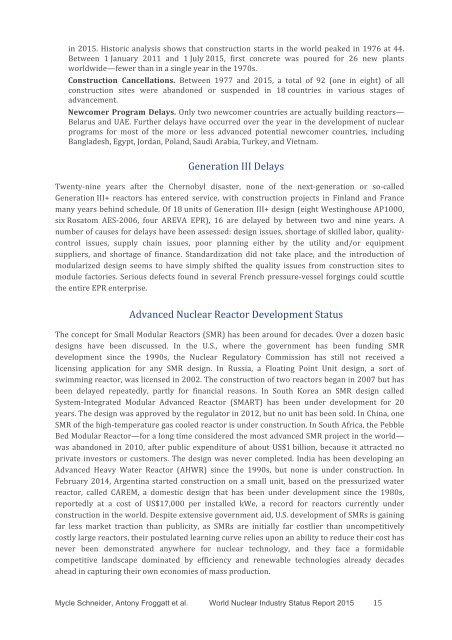PMFA1
PMFA1
PMFA1
Create successful ePaper yourself
Turn your PDF publications into a flip-book with our unique Google optimized e-Paper software.
in 2015. Historic analysis shows that construction starts in the world peaked in 1976 at 44.Between 1 January 2011 and 1 July 2015, first concrete was poured for 26 new plantsworldwide—fewer than in a single year in the 1970s.Construction Cancellations. Between 1977 and 2015, a total of 92 (one in eight) of allconstruction sites were abandoned or suspended in 18 countries in various stages ofadvancement.Newcomer Program Delays. Only two newcomer countries are actually building reactors—Belarus and UAE. Further delays have occurred over the year in the development of nuclearprograms for most of the more or less advanced potential newcomer countries, includingBangladesh, Egypt, Jordan, Poland, Saudi Arabia, Turkey, and Vietnam.Generation III DelaysTwenty‐nine years after the Chernobyl disaster, none of the next‐generation or so‐calledGeneration III+ reactors has entered service, with construction projects in Finland and Francemany years behind schedule. Of 18 units of Generation III+ design (eight Westinghouse AP1000,six Rosatom AES‐2006, four AREVA EPR), 16 are delayed by between two and nine years. Anumber of causes for delays have been assessed: design issues, shortage of skilled labor, qualitycontrolissues, supply chain issues, poor planning either by the utility and/or equipmentsuppliers, and shortage of finance. Standardization did not take place, and the introduction ofmodularized design seems to have simply shifted the quality issues from construction sites tomodule factories. Serious defects found in several French pressure‐vessel forgings could scuttlethe entire EPR enterprise.Advanced Nuclear Reactor Development StatusThe concept for Small Modular Reactors (SMR) has been around for decades. Over a dozen basicdesigns have been discussed. In the U.S., where the government has been funding SMRdevelopment since the 1990s, the Nuclear Regulatory Commission has still not received alicensing application for any SMR design. In Russia, a Floating Point Unit design, a sort ofswimming reactor, was licensed in 2002. The construction of two reactors began in 2007 but hasbeen delayed repeatedly, partly for financial reasons. In South Korea an SMR design calledSystem‐Integrated Modular Advanced Reactor (SMART) has been under development for 20years. The design was approved by the regulator in 2012, but no unit has been sold. In China, oneSMR of the high‐temperature gas cooled reactor is under construction. In South Africa, the PebbleBed Modular Reactor—for a long time considered the most advanced SMR project in the world—was abandoned in 2010, after public expenditure of about US$1 billion, because it attracted noprivate investors or customers. The design was never completed. India has been developing anAdvanced Heavy Water Reactor (AHWR) since the 1990s, but none is under construction. InFebruary 2014, Argentina started construction on a small unit, based on the pressurized waterreactor, called CAREM, a domestic design that has been under development since the 1980s,reportedly at a cost of US$17,000 per installed kWe, a record for reactors currently underconstruction in the world. Despite extensive government aid, U.S. development of SMRs is gainingfar less market traction than publicity, as SMRs are initially far costlier than uncompetitivelycostly large reactors, their postulated learning curve relies upon an ability to reduce their cost hasnever been demonstrated anywhere for nuclear technology, and they face a formidablecompetitive landscape dominated by efficiency and renewable technologies already decadesahead in capturing their own economies of mass production.Mycle Schneider, Antony Froggatt et al. World Nuclear Industry Status Report 2015 15


